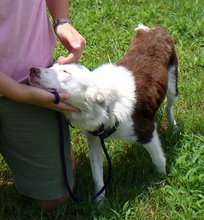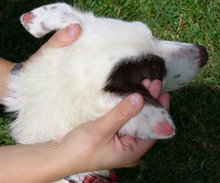Pat drove Maizie up to Texas A&M for special care today, a three hour round trip. Of course, everyone fell in love with her, especially the student assistant in charge of her during her stay (he’s a Border Collie person). Maize was sure to be extra special sweet to him! But once again, her condition has everyone stumped. She’s dehydrated, so they will keep her in ICU overnight to administer fluids, a delicate procedure for a dog with heartworms. Too many fluids too fast can kill them. A&M can also run digital x-rays, which have a clearer picture. We’re hoping the leak will show up somewhere in this new round of pictures.
Pat left A&M with no answers, but on the drive home she got a wonderful phone call. The images showed a small tear in her trachea, likely caused from the tube during her spay. This is how the air is leaking out into her body. The surgeons believe this will heal on it’s own in three to five weeks and the air pockets will be absorbed, so no surgery is necessary (a real blessing).
Death from Distemper or heartworms is not quick, the suffering is immense. There is no cure for Distemper, and any treatment available is only meant to ease suffering or help the dog stay strong enough to attempt to fight the virus on it’s own. Distemper slowly destroys, the lymphoid organs, respiratory organs, gastrointestinal organs, and urogenital organs, one-by-one. Most dogs that die from distemper, die from neurological complications, many of which are horrific to witness: swelling of the brain, seizures, deterioration of mental and muscle function, paralysis, disabling muscle spasms, depression and an increased sensitivity to stimuli like pain or touch. Heartworms is as equally devastating. Read Livy’s story to understand why waiting to see if a dog gets heartworms to take action is not only expensive but very, very dangerous for the dog.
Ruby was very, very lucky to have survived and found a wonderful home to live out a healthy and happy life. Her illnesses were easily avoidable with simple and relatively inexpensive preventive measures. Sadly, heartworm prevention costs only about $7-$10 a month, and the DHLP-P vaccination, which protects against more than just Distemper, costs only about $8-$12 a year. The cost in your time to carry out this prevention is even less. We hope that Ruby’s story (below) and the suffering she had to endure will educate so that other dogs don't have to suffer or die from these preventable diseases.
Ruby was very, very lucky to have survived and found a wonderful home to live out a healthy and happy life. Her illnesses were easily avoidable with simple and relatively inexpensive preventive measures. Sadly, heartworm prevention costs only about $7-$10 a month, and the DHLP-P vaccination, which protects against more than just Distemper, costs only about $8-$12 a year. The cost in your time to carry out this prevention is even less. We hope that Ruby’s story (below) and the suffering she had to endure will educate so that other dogs don't have to suffer or die from these preventable diseases.

May 25: My German Shepherd

May 17: Olivia, Henrietta, Sunshine and Ruby

April 10: First Trip to the Beach



















